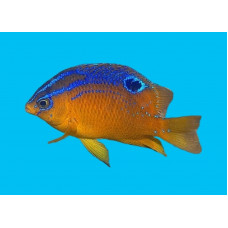Latin name
Parma oligolepis
Other name
Big-scaled parma, bigscaled scalyfin.
Identification
Large Parma have an oval body with flattened sides and a pointed muzzle. The eyes are large. The mouth is small and located at the very tip of the snout. The skin is covered with rather large scales.
Features of fish fins
Dorsal spines (total): 2; Dorsal soft rays (total): 17 - 20; Anal spines: 2; Anal soft rays: 13 - 15.
Fish colouring
Adults are dark, but without any markings on the operculum as in the closest relatives P. microlepis and P. alboscapularis. Juveniles are yellowish with blue markings from the head along the dorsum and dorsal fin, a blue circle under the eye and a blue spot on the posterior base of the dorsal fin.
Distribution
Common in the Western Pacific: eastern Australia between Cape Scorby, Queensland, and Sydney, New South Wales.
Habitat
Tropical marine species, inhabiting reefs. Depth from 2 to 20 metres.
Size
The maximum length of this species is 16,5 cm.
Behavior
Museum specimens indicate that this species is probably most common in coastal waters not associated with coral reefs, although one specimen in the Australian Museum was taken from Great Island on the Great Barrier Reef in Australia. It is a diurnal, non migratory species.
Food and feeding habits
Omnivorous. Feeds on plankton, algae and invertebrates.
Reproduction
The life cycle characteristics of the family indicate that this is an egg-laying group, with clear mating during reproduction. Eggs are on the bottom and attached to the substrate, males guard and aerate the eggs.
Fishing
Big-scale parma are not commercially important in the fishery.
Relationship with a person
Harmless.
| Classification | |
| Phylum | Chordata |
| Class | Actinopterygii |
| Squad | Perciformes |
| Family | Pomacentridae |
| Genus | Parma |
| Species | P. oligolepis |
| Features | |
| Conservation status | Least Concern |
| Habitat | Pelagic |
| Life span, years | No information |
| Maximum body weight, kg | No information |
| Maximum length, cm | 16,5 |
| Sailing speed, m/s | No information |
| Threat to people | Not edible |
| Way of eating | Planktonophage |
Big-scale parma
Tags: big scale parma

